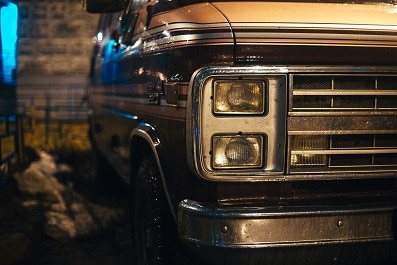There are several different problems you can have with your headlights, fortunately many of them you can fix without a mechanic.
There are several different types of headlights and often a van is sold with a choice or, a previous owner has changed them. You must therefore first establish which types of bulbs your van has.
Below are the most common problems and how to solve them:
- One Headlight Not Working – Change the bulb
- Neither Headlight is Working – Check they are receiving power
- High or Low Headlight Beam Not working – Check bulbs and fuses
- Headlights Appear Dim – Clean the lenses
- Brightness Fluctuates – Check electrical system
One Headlight Not Working
Although it can happen, it is very rare and unusual for both headlight bulbs to acquire a fault at the same time. This is despite them both undergoing the same stress and conditions.
If an electrical fault were to occur it is more likely that both headlights would be adversely affected. This means that in most instances when just one headlight fails to work, the bulb is probably the problem.
If the bulb has failed it will need to be changed however, first check its electrical connector.
The connector can sometimes come loose in which case it may just require you to push it back in place for the headlight to once again work. If the connector seems corroded or damaged it may not be allowing current to pass to the bulb.
If you suspect the connector is the problem, try connecting it to your known good headlight bulb. If that good bulb does not work either then the connection is the problem and the bulb which was not working may also be good.
Neither Headlight is Working
As mentioned it is unusual for both headlight bulbs to fail at the same time and so the chances are the bulbs are good and there is an electrical problem.
This does not however mean you will need assistance. The first thing to do is check the fuse box and see if the relevant fuse is broken. To do this remove the fuse and check if the metal strip running from end to end is not broken. If the strip is broken, you will need to change it.
When you do have to replace the fuse ensure you replace it with a fuse of the same amperage. Once you have done this your headlights should once again work as they should.
High or Low Headlight Beam Not Working
Once again if the problem only occurs to one headlight then the bulb is most likely the problem and you will have to change it.
If both headlights fail to dim or brighten, then there is a problem with the fuse or switch.
You can check the fuse yourself but will need assistance with checking the switch. The reason for this is because in order to check the switch, you will need tools. The dimmer switch is an intricate part of the steering column, and therefore you will have to remove this column to test the switch.
If the switch is at fault, it is unlikely it can be repaired, so you will have to replace it.
Headlights Appear Dim
If your headlights seem to be dimmer than they used to be, it may not be a problem with the lights themselves but instead, be due to dirty lenses.
There are three basic reasons that can cause headlight lenses to reduce brightness.
1. Clean the lenses if they are dirty:
The lenses may just be dirty, and if so you can clean them, and the headlights should once again seem brighter.
2. Remove water from lenses if they are foggy
This generally indicate that water is able to intrude into the headlight assembly. This means that as well as wiping off the fog, you will have to solve the problem of water in the assembly.
In some cases it is possible to drill a hole in a lens to remove the water. However, even if you can do this successfully, it would only be a temporary fix as water would soon get in again. It is perhaps best if you change the headlight assembly.
3. Replace or recondition foggy lenses
Due to a combination of UV light and debris from the road, oxidation can occur on your headlight lenses, causing them to appear dimmer. While many people will replace the headlight assemblies if this is the cause, it is possible to have the current lenses reconditioned instead.
When a headlight lens is reconditioned, first the oxidation is removed, and then a clear, protective coat is applied. Reconditioned lenses can often provide just as bright results as replacement headlights.
Brightness Fluctuates
If your headlight brightness seems to fluctuate, this is probably due to a problem with the van’s electrical system rather than the headlights themselves.
This is a problem which is often caused by extra electrical equipment being installed in the van, such as heavy duty amplifier. The lights are fluctuating due to the electrical system struggling to provide sufficient current to all the electrics. In these instances, the lights are the first thing to suffer insufficient power.
More often than not, a drop in power, or brightness of the lights, will be experienced while stopped at lights. Another sign of this being the problem is if the lights brighten and fade in time with the music on the stereo.
If there are excessive electrical devices in the van, the electrical system may struggle to produce enough power. However, the problem could also be that the alternator is faulty or problems with the wires.
First you will have to check if your battery is fully charged, if not then charge it and see if the problem persists.
Next you will have to check the alternator. You can easily do this on your own, but you will need a multimeter or voltage meter but little else. Instructions on how to do this can be found here.
If both your battery and alternator seem to be working correctly, you will have to consider all the electrical devices you have added to the van. If you do not want to disconnect any of the electrical devices, you will have to replace the alternator with a more powerful one. Your mechanic will be able to advise you further on which one to buy.
Conclusion
For safety and ease of driving, it is essential that your headlights function as they should and that they are bright enough.
Some of the problems can be easily resolved on your own prior to you next driving at night. If you need to consult a mechanic, that too should be done before you considering driving in the dark.
One thing to note is that while it is rare for both headlight bulbs to fail at exactly the same time, once one has failed, the other is likely to soon fail also. This is due to them both operating under similar conditions.
So, if you need to change one, it is worth considering changing them both at the same time to help avoid you having a repeat problem.
Although the lighting system in your van is relatively straight forward, problems can still arise from damaged wiring. As with the connections to the bulbs, check the wiring for breaks or signs of corrosion or other damage.
If you start to drive at night you probably check your lights before setting off which is good. If people start a journey in daylight though, they seldom check their lights before setting out, even if they know they will still be driving when it gets dark.
For the sake of safety it is recommended that you always check your lights before driving, day or night. In certain circumstances, you may need your lights during the day. Plus you may have unexpected delays which extend your drive into the darkness hours.
Regardless of the type of bulb your headlights have, their brightness will deteriorate over time and usage. While most people will wait until a bulb fails before changing it, this means their headlights can fail at a very inappropriate time. It is therefore recommended that headlight bulbs are changed about every 2 years.
As a driver, safety should always be your first concern, and so deciding to change your bulbs on time is as important as other periodic checks and services. The cost of a bulb is minimal compared to the costs and dishevel experienced when your lights fail.


